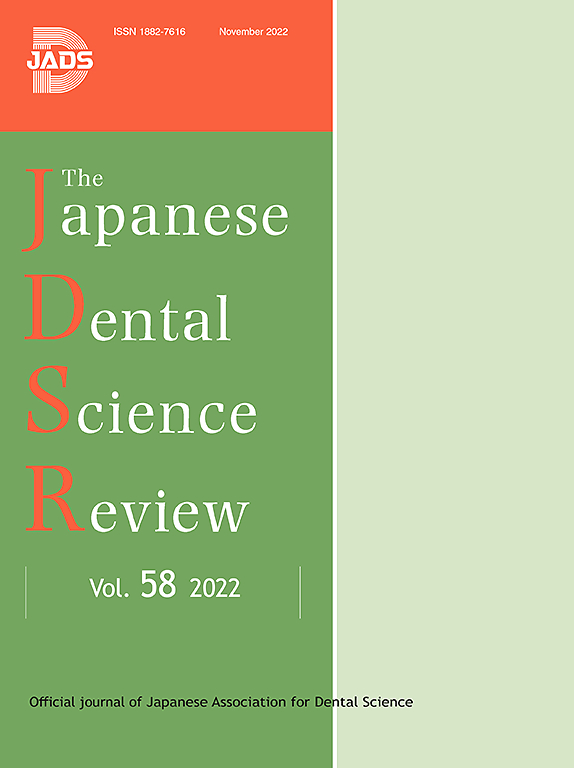Impact of active vs. passive application of dental adhesives on bond strength to dentin and enamel: A systematic review and meta-analysis of in vitro studies
IF 6.6
2区 医学
Q1 DENTISTRY, ORAL SURGERY & MEDICINE
引用次数: 0
Abstract
The application method of adhesive systems affects both immediate and long-term bond strength. This systematic review analyzed in vitro studies comparing active versus passive application of adhesives on enamel and dentin, regardless of classification. A comprehensive search was conducted in PubMed/Medline, Embase, Scopus, Web of Science, Lilacs, and Grey Literature. Included studies assessed bond strength with active or passive application. Meta-analyses were stratified by substrate (enamel and dentin) and application mode (etch-and-rinse or self-etching), using a random-effects model and I² index for heterogeneity. The RobDEMAT tool assessed the risk of bias. Out of 3022 articles, 23 met the inclusion criteria. Meta-analysis showed that passive application of universal adhesives in etch-and-rinse mode resulted in higher bond strength to enamel. However, active application of etch-and-rinse or universal adhesives in etch-and-rinse mode improved bond strength on dentin. For self-etching or universal adhesives in self-etching mode, active application enhanced bond strength on both enamel and dentin. Few studies assessed longevity, but those that did reported positive outcomes for active application. One self-curing universal adhesive showed significantly different results. In conclusion, active application improves bond strength to dentin in two-step etch-and-rinse mode and to unconditioned enamel and dentin in self-etching mode.
主动与被动应用牙胶粘剂对牙本质和牙釉质结合强度的影响:体外研究的系统回顾和荟萃分析
胶粘剂系统的应用方法会影响当前和长期的粘接强度。这篇系统综述分析了在体外的研究,比较了在牙釉质和牙本质上使用粘合剂的主动和被动应用,而不考虑分类。在PubMed/Medline、Embase、Scopus、Web of Science、Lilacs和Grey Literature中进行了全面的检索。纳入的研究评估了主动或被动应用的粘结强度。meta分析采用随机效应模型和I²异质性指数,按基质(牙釉质和牙本质)和应用模式(蚀刻-冲洗或自蚀刻)进行分层。RobDEMAT工具评估偏倚风险。在3022篇文章中,23篇符合纳入标准。荟萃分析显示,在蚀刻-冲洗模式下被动应用通用粘合剂可以提高牙釉质的结合强度。然而,主动应用蚀刻-冲洗或通用粘合剂在蚀刻-冲洗模式提高了牙本质的结合强度。对于自蚀刻或自蚀刻模式的通用胶粘剂,主动应用增强了牙釉质和牙本质的结合强度。很少有研究评估寿命,但那些确实报告了积极应用的积极结果。一种自固化万能胶效果有显著差异。综上所述,主动应用提高了两步蚀刻-冲洗模式下牙本质的结合强度,以及自蚀刻模式下无条件牙釉质和牙本质的结合强度。
本文章由计算机程序翻译,如有差异,请以英文原文为准。
求助全文
约1分钟内获得全文
求助全文
来源期刊

Japanese Dental Science Review
DENTISTRY, ORAL SURGERY & MEDICINE-
CiteScore
9.90
自引率
1.50%
发文量
31
审稿时长
32 days
期刊介绍:
The Japanese Dental Science Review is published by the Japanese Association for Dental Science aiming to introduce the modern aspects of the dental basic and clinical sciences in Japan, and to share and discuss the update information with foreign researchers and dentists for further development of dentistry. In principle, papers are written and submitted on the invitation of one of the Editors, although the Editors would be glad to receive suggestions. Proposals for review articles should be sent by the authors to one of the Editors by e-mail. All submitted papers are subject to the peer- refereeing process.
 求助内容:
求助内容: 应助结果提醒方式:
应助结果提醒方式:


